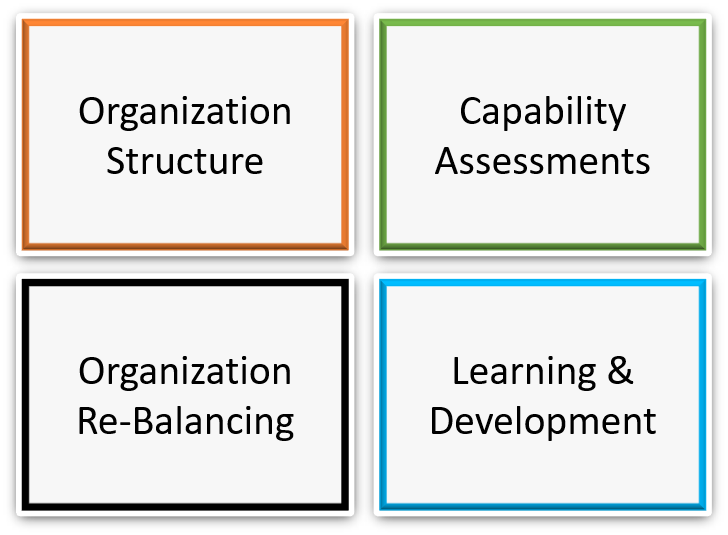Organization Assessment
Organization Assessment aims to improve organizational performance by aligning resources to maximize productivity and achieve results in the most efficient way possible.
By analyzing operational and individual performance in light of contribution to strategy and mission, I can identify both the potential savings in headcount re-balancing, and the type of capability development initiatives to be launched.

Organization Re-Balancing: Assessment of headcount – both direct and indirect, comparison with workload and industry norms, scope for redeployment to more mission-critical areas
Organization Structure: Assessment of interdepartmental bottlenecks, need for specific functions, reporting relationships, levels, span of control, roles and responsibilities, and customer-specific structures
Capability Assessment: Personnel, skills and assets required to support different activities – both customer-facing and supporting; availability of these elements in the organization and rating of criticality of each depending on mission and objectives; establishment of resource gaps; alignment to risk assessments.
Learning & Development: Addressing capability gaps as well as driving change during transformation by developing a L&D strategy, defining and building content, creating delivery mechanisms, and running training with feedback and monitoring loops to track actual changes.
- Organization diagnostics and recommendations covering:
- Organization suitability with respect to proposed strategies
- Manpower assessments and ‘Right-sizing’ the organization
- Roles and responsibilities – assessments and changing
- Organization design required to achieve competitive advantage, better customer servicing, removal of bottlenecks
Alignment between different business entities in the organization to enhance operating efficiencies and greater growth.
Creation/improvement of the capabilities required to support current and future business needs.
(The following is a non-exhaustive list of engagements provided as a sample of total experience)
Capability Assessment for a large Indian producer of ceramic products as part of a Corporate Planning exercise. This involved research on industry staffing and operating norms, an examination of the employee capabilities, and an assessment of the organization using a Burke Litwin Diagnostic.
Organization Structure Redesign for one of India’s largest and oldest automobile ancillaries manufacturer. After reviewing customer support needs through a Voice of Customer exercise, a detailed market-product strategy was drawn up and implemented along with structural changes in the areas of marketing, manufacturing, human resource management and purchase.
Corporate Plan for a major media group including an Organization Redesign driven by the proposed strategy and based on changes in market conditions and competitive moves. The proposed structure moved from a geographic focus to a brand-specific one and supported brand-specific marketing strategies.
Business Planning for a large government-owned public transport company in the Sultanate of Oman. The assignment involved developing a marketing and business strategy for the company, assessing the long term business model, and identifying operational weaknesses. The team developed routes, assessed fleet size and composition, and outlined a new organization structure that would facilitate and strengthen the execution of the proposed strategy and operational requirements.
Restructuring of Global Secretariat of International NGO in the UK – The central body of this multi-country affiliate-based operation was redesigned in terms of its approach, role, services and structure, moving from a support role to one providing common services and guidelines for old and new affiliates, entities, programs, countries, and functions. This was through a distributed structure based on a network of internal service providers. Elements, organization-wide standards and guidelines, and structures were defined for the new operating model, covering specific functional areas viz. Human Resources, Finance, IT, MIS & ERP
